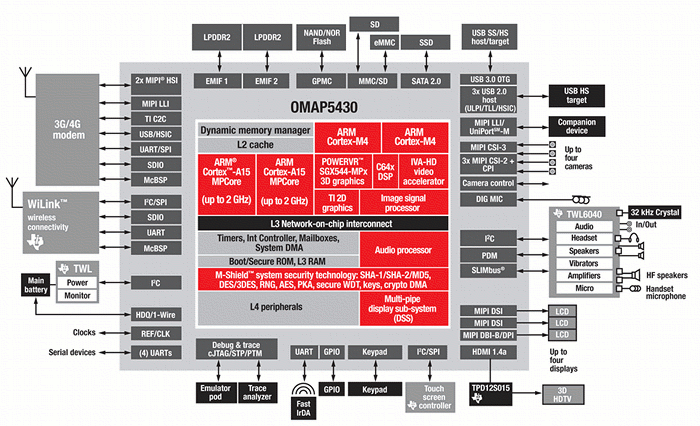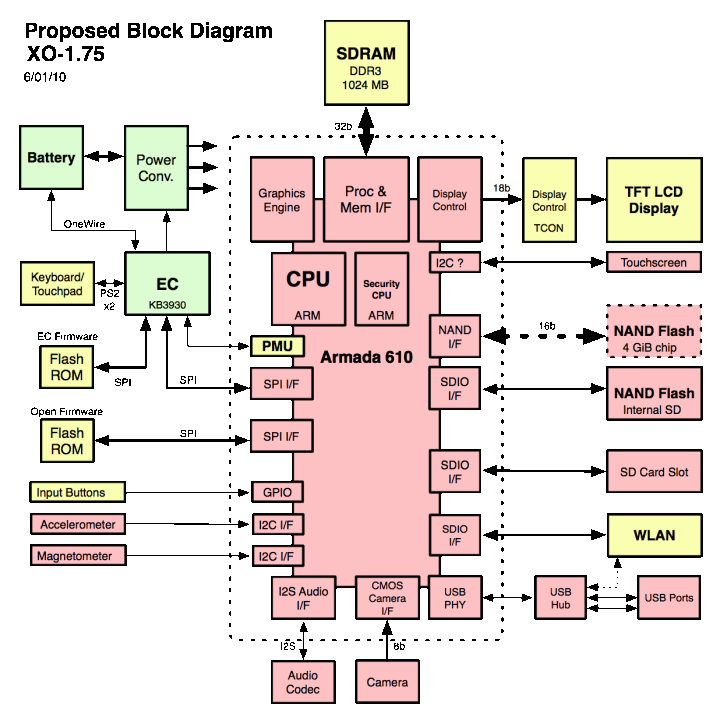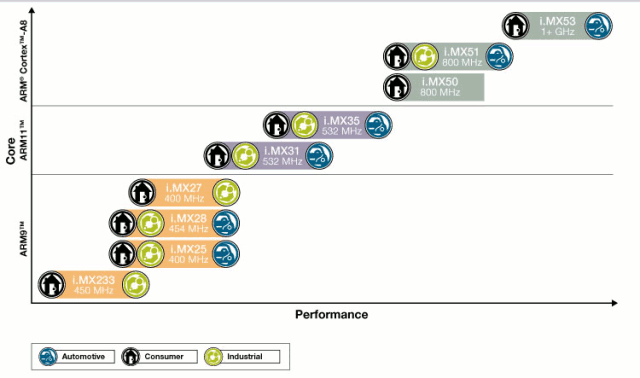HyperDevBox is a Japanese based software development company, developing games for Android. They are presenting their new Android game called “Spectral Souls”, the first tactical RPG game for Android. The interesting part is that this Android gamewas not developped with Java, but only using C/C++ programming with Android Native SDK (NDK) (Currently revision 5). Using the NDK means you’ll have to adapt your software to several hardware platform contrary to java development. They now only support Qualcomm and PowerVR GPU for now, and they are working on supporting NVidia Tegra platform and other upcoming GPU. The advantage of native code is a potential performance improvement and code re-use if you have already applications developed in C/C++, the inconvenience is that more work is need to support different hardware. Currently the NDK is only available for ARM platforms (ARMv5TE andARMv7-A), future releases will support x86 instructions. The video below is an […]
Linaro Development Board “Snowball” by ST Ericsson
ST Ericsson unveiled a development board based on Nova A9500 (dual ARM Cortex A9 processor and MALI 400 GPU) at MWC 2011 called Snowball (or SKY-S9500-ULP-CXX) for the embedded Linux community and professional developers. This board was designed by CALAO Systems and can be pre-ordered on their website for 200 USD (SKY-S9500-ULP-C11 / Software Development Kit – SDK) or 300 USD (SKY-S9500-ULP-C01 / Production development Kit – PDK). The difference between the SDK and PDK is that the former has no expansion connectors, no battery backup for RTC and only support serial over USB port (for Linux console). First, some pictures with description of the snowball development board. The full documentations for Snowball development board can be found in Calao Systems File Repository, where you’ll get the bottom and top assembly diagrams for both C01 and C11, the major components datasheet, documentation and some photos. The specifications of the boards: – […]
Qualcomm Augmented Reality Challenge Winner: Paparazzi
Qualcomm announced the winner of their augmented reality challenge developed with Qualcomm Augmented Reality Software Development Kit (QCAR SDK): The top prize of $125,000 was awarded to a team of two developers from Lithuania, Paulius Liekis and Arminas Didžiokas for Paparazzi, an interactive augmented reality game where the player becomes a virtual paparazzo and sneaks pictures of a vain celebrity before he gets agitated and attacks the photographer. The second (50,000 USD) and third (25,000 USD) prizes were also awarded to augmented reality games respectively Inch High Stunt Guy by Defiant Development Pty Ltd. (Australia), a game where the player arranges various obstacles to enable a stuntman to successfully jump his motorcycle through a hoop and Danger Copter by Alex Beachum, Jonghwa Kim, Jason Mathias, Kedar Reddy and Evan Sforza (USA), a gaming adventure where the player becomes a helicopter pilot who maneuvers a water-spouting chopper to extinguish fires and […]
Ziilabs ZMS-05 and ZMS-08 SDK and Development Boards
Ziilabs (originally 3DLABS) is Singapore company, subsidiary of Creative Technology, that provides media application processors for consumers electronics and has offices in the UK, China, USA and Singapore. Ziilabs Media Processors Overview Ziilabs has two media processors: ZMS-05 – A Low Power HD Programmable Media Rich Processor based on two ARM9 core (ARM9-EJS) mainly aimed at smartphones and tablets with the following media capabilities: High compute density SIMD architecture High resolution – decode to 1080p / 720p encode Simultaneous video encode/decode at D1 Wide rage of optimised CODECs and APIs Accelerated OpenGL ES 3D graphics Hardware compositing Advanced image processing 8 GFlops programmable compute ZMS-08 – A HD Media Rich Applications Processor based on an ARM Cortex A8 running @ 1GHz mainly aimed at media players, set-top boxes and digital signage solutions with the following media capabilities: Blu-ray Quality 1080p H.264 Video Decode 1080p H.264 Video Encode 720p H.264 Video […]
Texas Instruments OMAP 5 based on ARM Cortex A15 Core
Texas Instruments announced its new generation of mobile chips OMAP 5 based on the latest ARM core Cortex A15. Press release excerpt: DALLAS (Feb. 7, 2011) /PRNewswire/ — Texas Instruments Incorporated (TI) (NYSE: TXN) announced today the next generation of its popular OMAP™ family: the OMAP 5 mobile applications platform, which is positioned to transform how mobile devices, such as Smartphones, tablets and other mobile form factors are used, making them even more valuable in our daily lives. … The 28 nanometer OMAP 5 applications processors carry on the OMAP family tradition of delivering significant increases in performance and functionality, while lowering power consumption compared to their predecessors. Specifically, they offer up to 3x processing performance and five-fold 3D graphics improvement, yet provide a nearly 60 percent average power reduction compared to a sample user experience on the OMAP 4 platform. Additionally, the OMAP 5 platform’s software is designed for […]
Android 3.0 SDK Preview and Platform Highlights
Google has just released Android 3.0 (Honeycomb) preview SDK and platform highlights. Android 3.0 Highlights Summary New User Features: New UI designed from the ground up for tablets (larger screens) System Bar, for global status and notifications Action Bar, for application control: access to contextual options, navigation, widgets, or other types of content in the Action Bar, displayed at the top of the screen. Five Customizable Home screens with widgets, app shortcuts, and wallpapers using a dedicated visual layout mode. Recent Apps, for easy visual multitasking Redesigned keyboard to improve typing speed/accuracy on tablets. Improved text selection, copy and paste New connectivity options such as Media/Photo Transfer Protocol, USB / Bluetooth keyboards Updated set of standard apps for larger screens. Browser Improvements: Multi-tabs support, “incognito” mode, better browsing experience at non-mobile sites through an improved zoom and viewport model, overflow scrolling, support for fixed positioning, and more. Camera and Gallery: […]
OLPC XO 1.75 Hardware, Firmware and Software
OLPC demo’ed their 3rd generation laptop – OLCP XO 1.75 – based on Marvell Armada 610 at CES 2011. The good thing about this platform is that they opened most of it including the hardware, the software and for the first time the firmware. However, I found out it’s not so easy to find the hardware / software development information and source on the OLPC site, so I’ve decided to make a summary and provide links to the hardware, firmware and software for OLPC XO 1.75. OLPC XO 1.75 Hardware The XO-1.75 is powered by Marvell Armada 610 CPU (88AP610) with an ARM core clocked at 1Ghz. It has 1GB DDR3 SDRAM, 4GiB NAND Flash, a TFT display, an SD Card slot, Wi-Fi, a few USB ports and a camera. I believe the touchscreen is not part of the current hardware, but the block diagram below should be close to […]
Freescale i.MX Overview, SDK and Development Boards
Freescale i.MX Processors Overview Freescale i.MX multimedia applications processors are based on ARM9, ARM11 and ARM™ Cortex-A8 and Cortex-A9 core technologies “delivering an optimal balance of performance and long battery life for rich multimedia experiences on the go”. There are quite a few families within the Freescale i.MX Series namely: i.MXS Processors:ARM9 Core @ 100-200Mhz (i.MX1 (not recommended for new designs), i.MXL and i.MXS). i.MX21 Processors: ARM9 Core @ 233-266Mhz (i.MX21 and i.MX21S) i.MX23 Processors: ARM9 Core @ 454 Mhz (i.MX233) i.MX25 Processors: ARM9 Core @ 400MHz for industrial and automotive applications (i.MX251, i.MX253, i.MX255, i.MX257 and i.MX258) i.MX27 Processors: ARM9 Core @ 400Mhz for Video over IP, VoIP, Cordless and Mobile phones… (i.MX27 and i.MX27L) i.MX28 Processors: ARM9 Core @ 454 Mhz for industrial and consumer applications (i.MX281, i.MX283, i.MX285, i.MX286 and i.MX287) i.MX31 Processors: ARM11 Core @ 400-532 Mhz for industrial, consumer and automotive applications (i.MX31 and i.MX31L) […]









